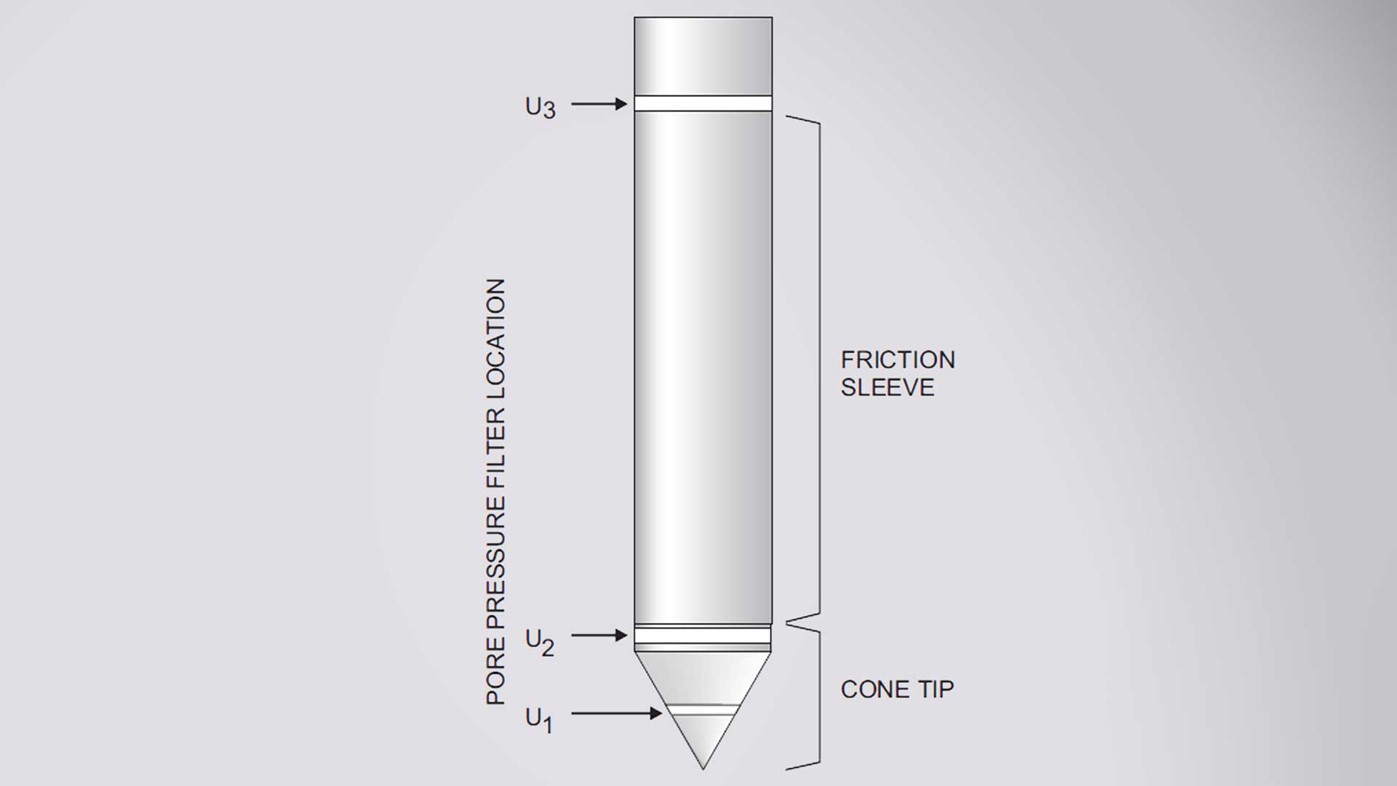The pore pressure is often measured during CPT, along with the cone tip resistance and sleeve friction. This is, however, not the hydrostatic pressure at the cone depth, but rather the dynamic pore pressure. The dissipation test helps to correct these measurements.
This article is shortened. You can download the full version.
One of the principles of CPT is that the cone is pushed down at a constant speed of 2 cm/s (0.8 in/s). As the cone moves downwards, excess pore pressure builds up around the cone tip and this means that the cone measures the dynamic pore pressure (normally u2, see Figure 2), which is the sum of the excess pore pressure (Δu) and the hydrostatic pressure (u0).
Whenever the cone penetration is stopped this excess pore pressure begins to dissipate and over time the pore pressure will revert to the hydrostatic pressure. The rate with which that occurs depends on the coefficient of consolidation, which in turn depends on the compressibility and permeability of the soil.

Figure 1: A CPT Dissipation test where pore pressure is recorded against time

Figure 2: Filter locations | Image source: ASTM D5778
The procedure for performing a dissipation is very simple. Of course the test relies on using a piezocone, so that pore pressure is measured. To perform a dissipation the user simply pauses the penetration, unclamps the tubes and starts the dissipation test in the CPT acquisition software.
It is important that this is all done quickly; as soon as the penetration is stopped the dissipation of the excess pore pressure is occurring, whether it is being recorded or not. The test is completed when the pore pressure measurements remain constant and reflect the hydrostatic pressure at the depth where the cone is located.
A very important part of the procedure starts before the test, that is the piezocone saturation or de-aeration. If the saturation process has not been properly carried out, the pore pressure response will not really reflect the dynamic pore pressure, and therefore data from dissipation testing may be inaccurate.
The type of soil encountered during CPT will govern how much excess pore pressure builds during penetration and the also the time required for that excess pore pressure to dissipate. In free draining materials, such as clean sands and gravels, pore water is able to drain in front of the advancing cone. This means that little, if any excess pressure is generated and the measured dynamic pore pressure is very close to hydrostatic pressure.
As a result, dissipation tests in sands will be very quick. It may actually be so quick that by the time the CPT tubes are unclamped the excess pore pressure has dissipated completely. In such cases the test should be repeated slightly deeper without unclamping the tubes.

Figure 3: Pore pressure response during drained vs undrained penetration | Image source: Cone Consultants Ltd, UK
In slow draining materials, such as clays and silts, pore water is unable to drain in front of the advancing cone and pore pressure builds up easily. This means that the excess pressure is high, the pressure decays slowly, and therefore the dissipation test will take much longer.
One use of the dissipation test is to assess the hydrostatic pressure at a given depth. The hydrostatic gradient can then be used to back calculate the water table level. If this is the objective, the test duration depends on the time required for the entire excess pore pressure to dissipate. While a dissipation test can be performed at any required depth, it only makes sense to perform the test in a sand or gravel layer; where the soil conductivity is much higher than in a silt or clay layer. Performing the test in sand or gravel would take no more than a few minutes, while in silt or clay layers the test could easily take hours, or even more than a day.
Another use of the test is to determine the hydraulic conductivity of the soil layer where the cone tip is located. In that case the test needs to be performed in that particular soil, but it is normally sufficient to reach 50% dissipation (t50), Figure 5, and then use the correlation shown in Figure 6 to determine the hydraulic conductivity.

Figure 5: Calculation of t50 | Image source: Cone Consultants Ltd, UK

Figure 6: Analysis of t50 | Image source: Parez and Fauriel (1988). "Le piezocone ameliorations apportees a la reconnaissance de sols." Revue Francaise de Geotech 44: 13-27
To perform a dissipation test does not require any additional equipment or set-up when compared with a standard piezocone CPT (CPTu) and it can be performed at any time during a CPT sounding. And, as is the case with the CPT results in general, the results are instantaneous, which means that the test outcome can be taken into account for the remainder of the CPT program at that particular site.
Performing a dissipation test is a useful addition to a CPT program at a particular site and should be considered as a standard part of each CPT program.